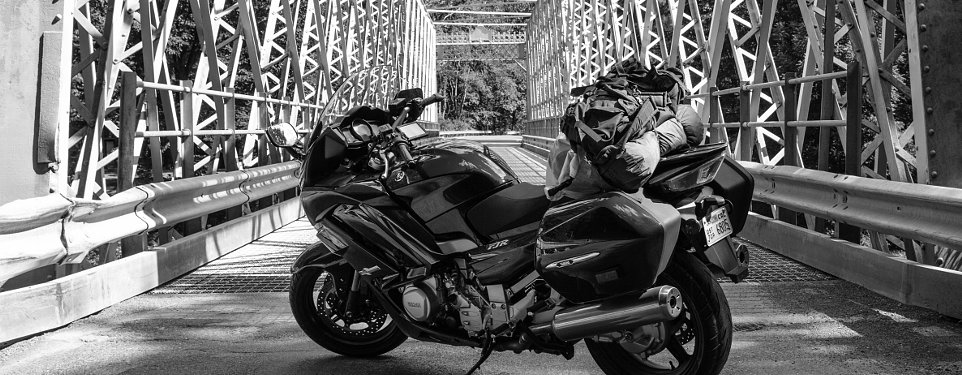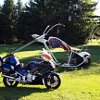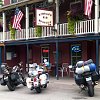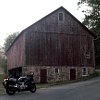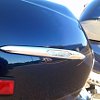"Newer" ain't always "better."
Clean-sheet redesigns can be exciting and fresh, but there's something to be said for long model runs à la Harley-Davidson Electra Glide or Kawasaki KE100. Redesigns are good for big, sweeping changes. But sometimes, when a product is almost a bullseye to begin with, fine-tuning can produce a familiar product that benefits from incremental changes. Throwing everything out would be a disservice to the customer.
For 2016, Yamaha updated the FJR1300 after a long and successful run. The FJR is probably at its pinnacle in terms of proficiency. That very ease of handling any type of street-riding situation, though, can also make the FJR seem mind-numbingly boring at times — a terrible trait in the highly emotional world of motorcycling.
With those two opposite thoughts in mind, I spent a good part of the summer riding a new FJR for a long-term assessment.

The bike
Sport-touring machines are generally middle-of-the-road machines. They're slower than a true back-breaker race rep, but they're still irresponsibly fast if you push them. They offer some creature comforts, but not the full-on opulence that comes with a straight touring bike. Heated handgrips are a sensible addition, but something like a radio is "too comfy." These bikes are incredibly good for going long-distance at an above-average pace, and if you're the type of rider who likes a long ride to a destination and then a daily thrashing of the asphalt once there, the sport-touring category has your name all over it.
Earlier this year, Spurgeon made a lovely video that highlighted some of the changes that came to the long-running FJR for 2016. I won't rehash what he covered too much, so if you want the details and full specs, be sure to pop on over and give it a look-see, along with his first ride article.
Sport tourers in general — and the FJR in particular — offer a surprising amount of ergonomic fiddling that can be performed by the rider, and I spent my first hundred miles setting up the FJR such that I was happy. Think of it like getting a suit tailored, or a guitar set up by a tech. After that, I spent time making myself unhappy, just to see what the range was. I began by adjusting both the brake and clutch levers as near to the grips as I could get ‘em. I would have preferred they come in even closer to the grips. I have big paws, so I have no idea who the hell is using the other settings, unless this is a bike built by Samoans.
A few days after my first spin, Spurg showed me the dual-height seat feature, which gives the FJR a seat height of either 31.7 inches or 32.5 inches. I preferred the lower setting. I have a 30-inch inseam, and I was happy to have a firm grip on the ground with such a top-heavy bike. The windshield is electrically adjustable (power windows?!), which is a nice touch. Height and angle change in lockstep, which is nifty. But I found that in the upright position, that screen just funneled all the wind into my kisser. If I was buying an FJR, I would be mentally accounting for a taller shield. (I’m six feet tall.) Yamaha sells this as an optional item. Too bad you can’t get one from the factory with the larger shield. One can also relocate side fairings to either admit or block off incoming air.

Testing the FJR1300
Once underway, the FJR proved to be staunchly reliable. It feels stable and planted everywhere and gathers speed with a grim determination. Its huge 6.6-gallon tank was a welcome change from the Yamaha XSR900 I was riding around this summer, because I stopped spending my whole damn life at gas stations talking about that bike. The FJR is nondescript enough that no one gave it a second look anyway.
For example, the drive modes, Sport and Touring, should have been renamed Sport and Boring. The throttle response was only acceptable to me in Sport mode. It was dulled to the point of laziness in Touring mode. Perhaps I am being unfair to those who want a bike that responds slowly and steadily when they grab a big handful of the “fast button.” It should be noted, too, that my test bike had a mechanical or electronic issue. There was no way to switch throttle modes other than turning the ignition key off and then on. It alternated between the two settings every time I went to the key-on, engine-off position. This issue seemed to fix itself a few thousand miles later when I turned the bike over to my esteemed colleague Buzzsaw.
The 1,298 cc engine motorvating the FJR has plenty of guts, though it is odd to see just a 9,000 rpm redline on a sporty inline-four. The bike’s happy to be short-shifted, which I like. I want to be relaxed, and I want the bike relaxed, too. With that out in the open, the FJR will flat-out scream if you wind out that big four. I mean, it will propel you to speeds that are positively scary, and you better be willing to hammer the brakes and toss the big pig over in the turns. It’s deceptively fast. The transmission upgrade from a five-cog box to a six-speed (which Yam made quite the fuss over) is wholly unnecessary. Why not just make fourth a touch taller, and five really tall, if the goal is reduced vibes at cruising velocity? If you’re riding this bike in a spirited fashion, odds are excellent you ain’t doing it in fourth gear or faster. It’s a touring bike! Who the hell wants to spend the whole ride shifting?
Braking on this boat is standard touring bike: just adequate. I felt like I had to stand on the rear pedal to get any power out of the FJR’s triple-disc linked brakes (320 mm duals up front, and a 282 mm single on the caboose end). I used He-Man strength to squeeze the front lever to the point where ABS was needed. It was nightmarish even trying to get the ABS to kick in for testing purposes, which is good: traction is lovely for braking. However, this bike takes a long time to stop when trying to extract maximum “whoa!” There’s nothing really wrong with the brakes. This is just a heavy and fast machine. Riding the FJR hard tested the limits of my mental and visual acuity. Leave room for braking errors; you might need it.
The bike handles really well for such a large machine. I got a lot closer to the ground than I ever expected this bike would let me. The caveat here is that the rider has to have the beans to pitch it over and the brawn to pick it back up. I could imagine taking this on any of the famous twisty roads and being significantly more tired at the end of it than someone on a smaller motorcycle. The front end is a little vague-feeling, but hey, this is not a racebike. Electronic, on-the-fly suspension changes spoiled me to no end, but I could live without it, especially since Spurg (who rode both the ES model and the standard one) told me the feedback is better on the standard model. The suspension was too soft unless I lied to it. (Fat Lem + lunch in the saddlebags = the “two helmets plus a suitcase” preload setting.)
Yamaha fit this thing with an excellent set of skins, Bridgestone BT-023s. I loved this tire the first go-around, and I like the re-issue just as well. Our FJR felt sure-footed the whole time I rode it, and I did manage to wear the skins almost edge to edge. Interestingly, by 5,000 miles the rear was starting to flat-spot from slab usage, and the front was developing some super-funky wear patterns. The rear did not seem to affect handling much at all, though the front started to develop some growl and shake that you could feel through the handlebars upon very hard braking. Oddly, I never felt chatter, even when deep in turns. Not bad for a stock tire, but I imagine they’ll degrade quickly from this point on. Still, not a bad performance at all.

I was comfy on the FJR. It’s either exceptionally roomy if you’re comparing it to a sportbike, or “not cramped” if you are comparing it to a tourer. The seat is wide — almost too wide. The width is easy on the ass, but makes the bike seem taller than it is because it forces the rider’s legs apart. The riding position has almost no “sport” to it. I found the bars to have more sweep than I expected. I also really felt like I had to throw my chest into turns, and I think it might have to do with the narrow bars. Spurg noted this as well. I got curious and dug me out a tape measure. The FJR bars measure 27 inches wide. For comparison’s sake, that XSR900 I just finished testing measures 29 inches and it weighs over 200 pounds less than the FJR’s 642-pound wet weight. No wonder I was working the handlebars. Maybe Spurgeon is stronger than I am. (Spoiler alert: He’s not.)
Traction control is standard. It’s got one setting, and it is easily defeatable with a single button press. I could make it kick in by goosing the old girl when it was wet, and once I hopped the front wheel. (There was maybe enough room under the tire for a credit card.) Whatever. It’s a conservative touring bike, most riders do not want to be assing around on it like I do on all motorcycles.

The final item that was updated and needs discussin’ is lighting. The FJR sports full LED lighting. The ES model also has an adaptive headlight. The cornering lights illuminate sequentially at 7, 11, and 16 degrees of lean angle. Here’s my take: LED lighting is trick. I hate replacing bulbs. The headlights may be the best I have ever used on a motorcycle. These headlights flat-out work. The adaptive feature? Totally gimmicky. I mean, they work as advertised, but I don’t feel they improved how fast I could ride. Spurg and I both loved the lights, but only one of us was enamored with the adaptive nature of the headlamps, and it wasn’t me.
FJR highlights
The bike is comfortable and competent. The hard bags make carrying all manner of things easy. The ability to just slay highway miles made this a joy for commuting. Cruise control makes balancing the need to cover ground with the desire to avoid po-po interaction effortless. My wife was very comfy on the back. On paper, this is a bike that ticks so many boxes off for me. It’s fast, heavy, comfy, and infinitely useful because it carries things.
Adding to the comfort are items such as the electric ‘shield, heated grips, and an automatic power locking pocket in the fairing. I would like to mention that I love heated grips. They’re most helpful in the dead of winter when one needs them for sub-zero temps, but they are a treat for spoiled riders like me when the fall just turns nippy like it is now. The motorcycle also has lots of safety features, like those LED lights, those linked brakes, ABS, and a softer Touring drive mode that would be perfect for rain, to name a few.
The new-for-’16 slipper/assist clutch really has a light pull. Even two-fingering it, I didn’t mind sitting in traffic. And, low-tech though it may be, this bike has a centerstand, which is much appreciated. Parking is easier, as are tire changes. I love centerstands.
Another small item that made my life easy was the location of the oil drain plug, sightglass, and filler. They're all right next to each other, and the filter is on the side of the bike, not the bottom. Oil changes are a cinch on this thing.
Just in case the features available from Yamaha aren't enough, aftermarket support is also strong, because of the FJR's nice long model run. If you need reasons to buy an FJR, there isn’t a shortage.

FJR lowlights
My list of lowlights is longer than I had hoped for. First, forgive the rant, but why can I not get normal split brakes in a sport-touring bike? Gah. Are there legions of touring riders who just cannot get the hang of applying the front and rear brakes proportionally? Every time I went to scrub some speed using the rear of the FJR pre-corner, I upset the front and had to remember afresh how much I generally dislike linked brakes.
Another big lowlight for me is the cost of the FJR. At $16,390 for the base version and $17,990 for an ES like we got, this bike ain’t cheap. I’m fine with a bike that carries a premium, but I am likely to review it with a fine-tooth comb. The FJR has received substantial updates over the years, as opposed to clean-sheet re-designs. That does keep the aftermarket alive and vibrant, but it also means the bike feels, at least to me, a bit stagnant. Box section subframe? LCD info screen? Is it still 1999?
Bag space stinks. My 2XL lid wouldn’t fit in either bag, but Lance’s medium helmet did. I’d need a six-pack rack for this bike if it was going to be a Mrs. Lemmy hauler. Spurg and I both agreed on this point, too. I’m going to slip into “curmudgeonly old man mode” for a moment and state that I long for the days of bags that are not paint-matched to the bike. Bags stick way out and take some abuse when they are removed from the bike. Textured plastic suits me just fine; there’s no loss of color and the texturing usually hides the scuffs and scrapes that our FJR racked up even in a short testing window. One of the bags took a bad scrape to the paint at the hands of a parking lot mishap, and I spent an hour and three beers making it look presentable again.

Let me relate one other odd downer about the FJR: I was riding along and got caught in a rainstorm. To tell the story correctly, you need know that a rider must lock the panniers to remove the key from them. Also important: the hazard lights do not work without a key. Now, I don’t fault the engineers for what happened next, but a tester should have caught it. I pulled over to get rain gear out of the saddlebag, but I had to turn off the damned lights because I was removing the key to access my waterproofs. The very moment I most needed safe lighting, I couldn’t have it. Boo to you, Yamhammer. Hire a new tester.
Editor's note: After this story was published, reader Tim pointed out that Yamaha has a simple solution to this problem. Turn the steering to the left, turn the key to the left, and the lights can be left on with the key removed. So Lemmy retracts his "boo" to Yamhammer.
Here's a tiny downside to the aforementioned easy oil change: the FJR uses juuuuust over four quarts of oil. Put four in, and you're on the low side in the sightglass. So you'll buy five quarts, and have most of one left over. If you're like me, you'll forget this repeatedly, so in practice, you'll have enough oil left over for a "freebie" every fifth change.
Ultimately, though, my biggest disappointment with the big FJR was totally intangible and perhaps not even a fair criticism: The bike did not excite me. I normally love big, fast, comfy bikes, and this one was just so stoic and stalwart, it should have been off the charts for me. Riding it, however, felt very clinical and sanitary. Nothing got my heart racing for this bike, especially at its price. I wouldn’t fault a single rider for buying this bike, because it’s such a solid contender. However, it just did not make my socks go up and down. When anyone asked about it, I kept telling them, “It’s the Toyota Avalon of motorcycles.” It’s nicely appointed and there is no job on pavement it cannot handle with complete ease, but ultimately, no one has ever lusted after a Toyota Avalon.
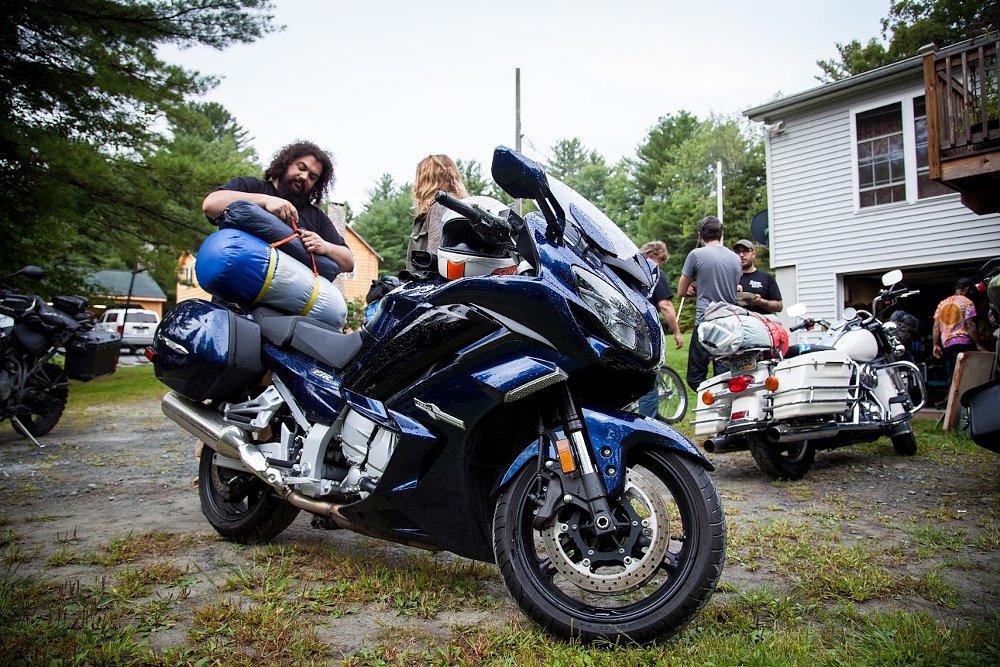
Fuel information
The longest haul I recorded on one tank was almost a pure highway run, with the big Yam eking 210 miles out of a tank. I was on reserve for 0.7 miles. I did not ever load this bike down with an auxiliary fuel source, so I never tested reserve range. I never put more than 5.2 gallons in the tank on any fill, so that leads me to believe that this bike either has a huge reserve, or lots of the fuel is inaccessible, because listed tank capacity is 6.6 gallons. I have read of at least one FJR owner pulling 300 miles out of a single tank, but I sure as hell wouldn’t try it. Honestly, the difference is academic. I can stand a leg-stretch anywhere between 210 to 300. The FJR also does that weird “counting up from reserve” thing Yamahas seem to do as of late. The fuel gauge on the FJR has eight bars, so it’s actually calibrated pretty nicely, and with the exception of the last hash mark or two, drops as you would expect it to, nice and evenly.
The FJR’s on-board fuel calculator very consistently pegged my fuel mileage between 43 and 44 miles per gallon, but actual math shows that it was more like 40 to 41. Best actual mileage was 42.7 mpg. Please keep in mind these are real-world tests. Sometimes I was flogging the FJR, sometimes I was gentle on the throttle. These tests, over the course of 3,000 miles, included a mix of city, two-lane, and highway riding on nearly every tank of fuel.
The FJR is equipped with an “Eco” minder to let heavy-handed throttle jockeys know when they are conserving (or wasting) fuel. I think there’s an algorithm that takes into account throttle position (or intake vacuum), vehicle speed, and gear position, but it seems like it’s not foolproof. Let me tell you, it was damn surreal to look down at the dash, and see that I was being “ecologically friendly” clipping up I-81 in New York at 94 mph. Nope, I’m not joking.
The competition
There are lots of bikes in this space, but I think the most direct and obvious competitor is the Kawasaki Concours 14. The base Kawi ($15,499) is almost a grand cheaper than the base FJR ($16,390), and it’s a touch more powerful. The Connie has a smaller tank (5.8 gallons), if that matters to your plans. The FJR, at 635 pounds, is a whopping 55 pounds lighter than the Connie. Perhaps notably, the Concours has that keyless Kipass proximity starting system that’s either a blessing or a curse, depending on how much you love technology or hate digging for your key. Potential buyers really should be letting the test rides help guide the decision between the two. I'm guessing people who are looking at these bikes are doubtless long-time riders with a few bucks to burn — they're the kind of people likely to be picky about getting exactly what they want.
Another FJR competitor is the BMW K 1600 GT, but at $21,995, it seems slightly unfair to stack them up against one another. The Triumph Trophy seems a bit closer, at $19,500. In any event, the big Yam certainly has its fans. Really, when you consider how competent every bike in this category is at going the distance, tiny creature comforts and unbelievably subtle and subjective characteristics are probably going to be the deciding factors for quite a few riders, and that makes sense: At their core, all of the bikes the FJR competes with are immensely adroit motorcycles. It’s safe to say the FJR holds its own among the other comers, and bests some of them in some scenarios.

Conclusion
I had such mixed feelings when I handed over the keys to the Yamaha because the bike is so utterly adept. It did everything I asked without a word of complaint and the faults I found were unbelievably minor. Why then do I feel so underwhelmed?
At one point while riding the FJR, I remember feeling a warm security like the stability of a bond index fund. I was inspired to freshen up my home’s backup generator (also a Yamaha product), faithfully cleaning the carburetor, before the next power outage. The FJR’s practicality encourages such responsibility. The bikes that make my heart go pitter-pat are bitchy, cantankerous machines that floor me with their looks and voices. They have powerplants that are so lively and quirky that riders often tend to personify them. The FJR, on the other hand, removes so many of the small hardships of motorcycling that it seems to strip motorcycling of its inherent danger and inconvenience.
One of the reasons I admire my wife is that she’s often able to look objectively at situations in a way I cannot. Mrs. Lemmy usually displays good judgment, and she also spent lots of time on the back of this bike, so I’m going to copy her notes on the bike verbatim.
“The most important thing to note for your readers is that it's a reliable but boring ride. Nothing is going to break, it's comfortable, and we could probably ride for weeks on that with no issues. I love that we can carry lots of gear on it. But exciting it is not.”
For some riders, the bike is central to the experience of riding. The journeys are a partnership, with both bike and rider having good and bad days, each working with or against the other as the relationship dynamics progress and change. For another class of rider, the bike is a tool; a machine to move the body to places and experiences that cannot be had close to home or by way of another conveyance. The FJR is the perfect companion for that rider.
| 2016 Yamaha FJR1300ES | |
|---|---|
| Price | $17,990 |
| Engine | Liquid-cooled DOHC 16-valve inline four-cylinder |
| Displacement | 1,298 cc |
| Bore x stroke | 79.0 mm x 66.2 mm |
| Compression ratio | 10.8:1 |
| Front suspension | 43 mm inverted fork with electronically adjustable rebound and compression damping, 5.3 inches travel |
| Rear suspension | Single shock with electronically adjustable spring preload, compression, and rebound damping, 4.9 inches travel |
| Front brake | Dual 320 mm discs; Unified Brake System and ABS |
| Rear brakes | 282 mm disc; Unified Brake System and ABS |
| Front tire | 120/70ZR17 |
| Rear tire | 180/55ZR17 |
| Length | 87.8 inches |
| Width | 29.5 inches |
| Height | 52.2 inches |
| Wheelbase | 60.8 inches |
| Ground clearance | 4.3 inches |
| Fuel capacity | 6.6 gallons |
| Fuel economy | 36 mpg |
| Weight | 642 pounds (wet) |




